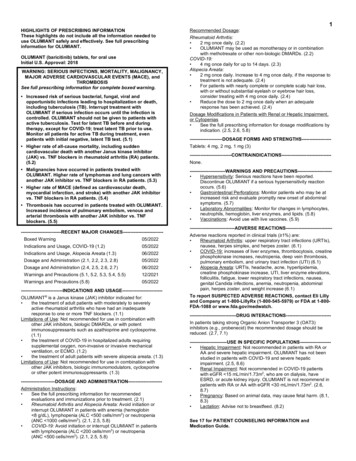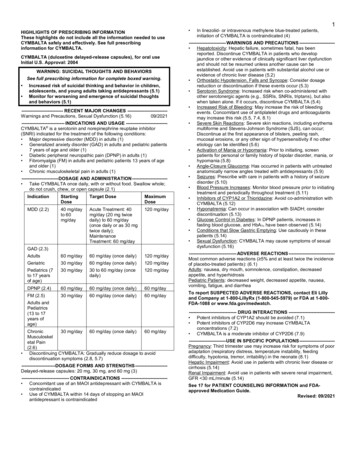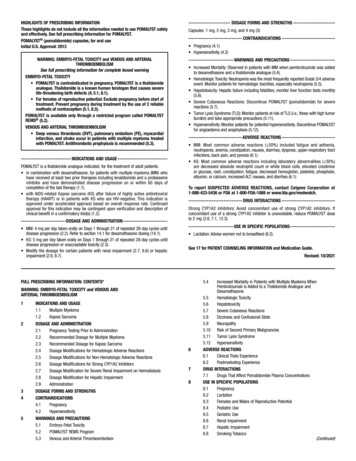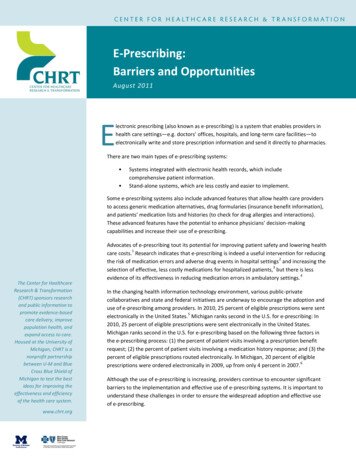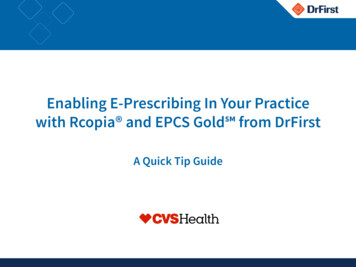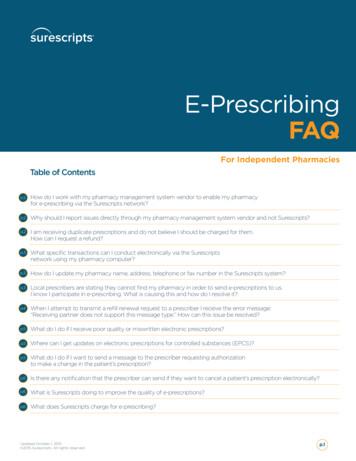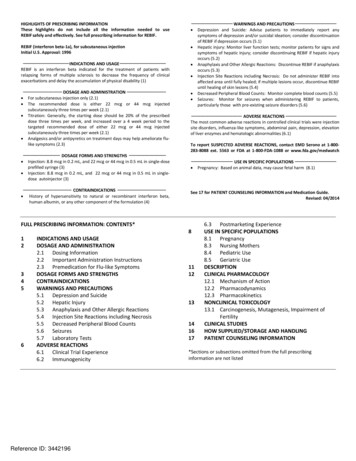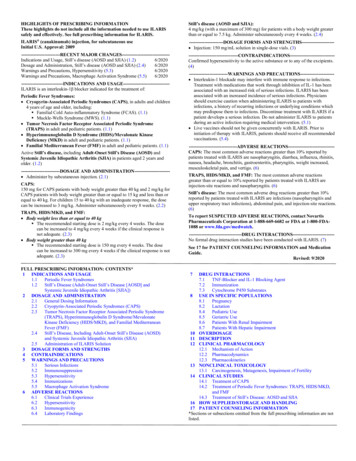
Transcription
HIGHLIGHTS OF PRESCRIBING INFORMATIONThese highlights do not include all the information needed to useRUXIENCE safely and effectively. See full prescribing information forRUXIENCE.RUXIENCETM (rituximab-pvvr) injection, for intravenous useInitial U.S. Approval: 2019RUXIENCE (rituximab-pvvr) is biosimilar* to RITUXAN (rituximab).WARNING: FATAL INFUSION-RELATED REACTIONS, SEVEREMUCOCUTANEOUS REACTIONS, HEPATITIS B VIRUSREACTIVATION and PROGRESSIVE MULTIFOCALLEUKOENCEPHALOPATHYSee full prescribing information for complete boxed warning. Fatal infusion-related reactions within 24 hours of rituximabinfusion; approximately 80% of fatal reactions occurred with firstinfusion. Monitor patients and discontinue RUXIENCE infusion forsevere reactions (5.1, 6.1).Severe mucocutaneous reactions, some with fatal outcomes (5.2).Hepatitis B virus (HBV) reactivation, in some cases resulting infulminant hepatitis, hepatic failure, and death (5.3).Progressive multifocal leukoencephalopathy (PML) resulting in death(5.4, 6.2).--------------------------- INDICATIONS AND USAGE---------------------------RUXIENCE (rituximab-pvvr) is a CD20-directed cytolytic antibody indicatedfor the treatment of adult patients with: Non-Hodgkin’s Lymphoma (NHL) (1.1). Relapsed or refractory, low grade or follicular, CD20-positive B-cellNHL as a single agent. Previously untreated follicular, CD20-positive, B-cell NHL incombination with first line chemotherapy and, in patients achieving acomplete or partial response to a rituximab product in combinationwith chemotherapy, as single-agent maintenance therapy. Non-progressing (including stable disease), low-grade,CD20-positive, B-cell NHL as a single agent after first-linecyclophosphamide, vincristine, and prednisone (CVP) chemotherapy. Previously untreated diffuse large B-cell, CD20-positive NHL incombination with (cyclophosphamide, doxorubicin, vincristine, andprednisone) (CHOP) or other anthracycline-based chemotherapyregimens. Chronic Lymphocytic Leukemia (CLL) (1.2). Previously untreated and previously treated CD20-positive CLL incombination with fludarabine and cyclophosphamide (FC). Granulomatosis with Polyangiitis (GPA) (Wegener’s Granulomatosis)and Microscopic Polyangiitis (MPA) in adult patients in combination withglucocorticoids (1.3).----------------------- DOSAGE AND ADMINISTRATION ---------------------- Administer only as an intravenous infusion (2.1). Do not administer as an intravenous push or bolus (2.1). RUXIENCE should only be administered by a healthcare professionalwith appropriate medical support to manage severe infusion-relatedreactions that can be fatal if they occur (2.1). The dose for NHL is 375 mg/m2 (2.2). The dose for CLL is 375 mg/m2 in the first cycle and 500 mg/m2 inCycles 2-6, in combination with FC, administered every 28 days (2.3). The dose as a component of Zevalin (ibritumomab tiuxetan) TherapeuticRegimen is 250 mg/m2 (2.4). The induction dose for patients with active GPA and MPA in combinationwith glucocorticoids is 375 mg/m2 once weekly for 4 weeks. The followReference ID: 4466227up dose for patients with GPA and MPA who have achieved diseasecontrol with induction treatment, in combination with glucocorticoids istwo 500 mg intravenous infusions separated by two weeks, followed by a500 mg intravenous infusion every 6 months thereafter based on clinicalevaluation (2.5).--------------------- DOSAGE FORMS AND STRENGTHS -------------------- Injection: 100 mg/10 mL (10 mg/mL) and 500 mg/50 mL (10 mg/mL)solution in single-dose vials (3).------------------------------ CONTRAINDICATIONS -----------------------------None (4).----------------------- WARNINGS AND PRECAUTIONS ---------------------- Tumor lysis syndrome: Administer aggressive intravenous hydration,anti-hyperuricemic agents, monitor renal function (5.5). Infections: Withhold RUXIENCE and institute appropriate anti-infectivetherapy (5.6). Cardiac adverse reactions: Discontinue infusions in case of serious or lifethreatening events (5.7). Renal toxicity: Discontinue in patients with rising serum creatinine oroliguria (5.8). Bowel obstruction and perforation: Consider and evaluate for abdominalpain, vomiting, or related symptoms (5.9). Immunizations: Live virus vaccinations prior to or during RUXIENCEtreatment not recommended (5.10). Embryo-Fetal toxicity: Can cause neonatal harm. Advise of potential riskto neonates and use of effective contraception (5.11).------------------------------ ADVERSE REACTIONS -----------------------------Most common adverse reactions in clinical trials were: NHL ( 25%): infusion-related reactions, fever, lymphopenia, chills,infection and asthenia (6.1). CLL ( 25%): infusion-related reactions and neutropenia (6.1). GPA and MPA ( 15%): infections, nausea, diarrhea, headache, musclespasms, anemia, peripheral edema (other important adverse reactionsinclude infusion-related reactions) (6.1).To report SUSPECTED ADVERSE REACTIONS, contact Pfizer Inc. at1-800-438-1985 or FDA at 1-800-FDA-1088 or - DRUG INTERACTIONS------------------------------Renal toxicity when used in combination with cisplatin (5.8).----------------------- USE IN SPECIFIC POPULATIONS ---------------------- Lactation: Advise not to breastfeed (8.2). Geriatric Use: In CLL patients older than 70 years of age, exploratoryanalyses suggest no benefit with the addition of rituximab to FC (8.5).See 17 for PATIENT COUNSELING INFORMATION and MedicationGuide.*Biosimilar means that the biological product is approved based on datademonstrating that it is highly similar to an FDA-approved biologicalproduct, known as a reference product, and that there are no clinicallymeaningful differences between the biosimilar product and the referenceproduct. Biosimilarity of RUXIENCE has been demonstrated for thecondition(s) of use (e.g. indication(s), dosing regimen(s), strength(s),dosage form(s), and route(s) of administration described in its FullPrescribing Information.Revised: 7/2019
FULL PRESCRIBING INFORMATION: CONTENTS*WARNING: FATAL INFUSION-RELATED REACTIONS, SEVEREMUCOCUTANEOUS REACTIONS, HEPATITIS B VIRUSREACTIVATION and PROGRESSIVE MULTIFOCALLEUKOENCEPHALOPATHY1 INDICATIONS AND USAGE1.1Non-Hodgkin’s Lymphoma (NHL)1.2Chronic Lymphocytic Leukemia (CLL)1.3Granulomatosis with Polyangiitis (GPA) (Wegener’sGranulomatosis) and Microscopic Polyangiitis (MPA)2 DOSAGE AND ADMINISTRATION2.1Important Dosing Information2.2Recommended Dose for Non-Hodgkin’s Lymphoma (NHL)2.3Recommended Dose for Chronic Lymphocytic Leukemia (CLL)2.4Recommended Dose as a Component of Zevalin for Treatment ofNHL2.5Recommended Dose for Granulomatosis with Polyangiitis (GPA)(Wegener’s Granulomatosis) and Microscopic Polyangiitis (MPA)2.6Recommended Dose for Premedication and ProphylacticMedications2.7Administration and Storage3 DOSAGE FORMS AND STRENGTHS4 CONTRAINDICATIONS5 WARNINGS AND PRECAUTIONS5.1Infusion-Related Reactions5.2Severe Mucocutaneous Reactions5.3Hepatitis B Virus (HBV) Reactivation5.4Progressive Multifocal Leukoencephalopathy (PML)5.5Tumor Lysis Syndrome (TLS)5.6Infections5.7Cardiovascular Adverse Reactions5.8Renal Toxicity5.9Bowel Obstruction and Perforation5.10 Immunization5.11 Embryo-Fetal Toxicity5.12 Concomitant Use with Other Biologic Agents and DMARDS inGPA and MPAReference ID: 4466227678111213141617ADVERSE REACTIONS6.1Clinical Trials Experience in Lymphoid Malignancies6.2Clinical Trials Experience in Granulomatosis with Polyangiitis(GPA) (Wegener’s Granulomatosis) and Microscopic Polyangiitis(MPA)6.3Immunogenicity6.4Postmarketing ExperienceDRUG INTERACTIONSUSE IN SPECIFIC POPULATIONS8.1Pregnancy8.2Lactation8.3Females and Males of Reproductive Potential8.4Pediatric Use8.5Geriatric UseDESCRIPTIONCLINICAL PHARMACOLOGY12.1 Mechanism of Action12.2 Pharmacodynamics12.3 PharmacokineticsNONCLINICAL TOXICOLOGY13.1 Carcinogenesis, Mutagenesis, Impairment of FertilityCLINICAL STUDIES14.1 Relapsed or Refractory, Low-Grade or Follicular, CD20-Positive,B-Cell NHL14.2 Previously Untreated, Low-Grade or Follicular, CD20-Positive,B-Cell NHL14.3 Diffuse Large B-Cell NHL (DLBCL)14.4 Ninety-Minute Infusions in Previously Untreated Follicular NHLand DLBCL14.5 Chronic Lymphocytic Leukemia (CLL)14.6 Granulomatosis with Polyangiitis (GPA) (Wegener’sGranulomatosis) and Microscopic Polyangiitis (MPA)HOW SUPPLIED/STORAGE AND HANDLINGPATIENT COUNSELING INFORMATION*Sections or subsections omitted from the full prescribing information are notlisted.
FULL PRESCRIBING INFORMATIONWARNING: FATAL INFUSION-RELATED REACTIONS, SEVERE MUCOCUTANEOUSREACTIONS, HEPATITIS B VIRUS REACTIVATION and PROGRESSIVE MULTIFOCALLEUKOENCEPHALOPATHYInfusion-Related ReactionsAdministration of rituximab products can result in serious, including fatal, infusion-relatedreactions. Deaths within 24 hours of rituximab infusion have occurred. Approximately 80% of fatalinfusion reactions occurred in association with the first infusion. Monitor patients closely. DiscontinueRUXIENCE infusion for severe reactions and provide medical treatment for Grade 3 or 4infusion-related reactions [see Warnings and Precautions (5.1), Adverse Reactions (6.1)].Severe Mucocutaneous ReactionsSevere, including fatal, mucocutaneous reactions can occur in patients receiving rituximab products[see Warnings and Precautions (5.2)].Hepatitis B Virus (HBV) ReactivationHBV reactivation can occur in patients treated with rituximab products, in some cases resulting infulminant hepatitis, hepatic failure, and death. Screen all patients for HBV infection before treatmentinitiation, and monitor patients during and after treatment with RUXIENCE. Discontinue RUXIENCEand concomitant medications in the event of HBV reactivation [see Warnings and Precautions (5.3)].Progressive Multifocal Leukoencephalopathy (PML)Progressive Multifocal Leukoencephalopathy (PML), including fatal PML, can occur in patientsreceiving rituximab products [see Warnings and Precautions (5.4), Adverse Reactions (6.2)].1INDICATIONS AND USAGE1.1Non-Hodgkin’s Lymphoma (NHL)RUXIENCE (rituximab-pvvr) is indicated for the treatment of adult patients with: 1.2Relapsed or refractory, low-grade or follicular, CD20-positive, B-cell NHL as a single agent.Previously untreated follicular, CD20-positive, B-cell NHL in combination with first line chemotherapyand, in patients achieving a complete or partial response to a rituximab product in combination withchemotherapy, as single-agent maintenance therapy.Non-progressing (including stable disease), low-grade, CD20-positive, B-cell NHL as a single agentafter first-line cyclophosphamide, vincristine, and prednisone (CVP) chemotherapy.Previously untreated diffuse large B-cell, CD20-positive NHL in combination with cyclophosphamide,doxorubicin, vincristine, prednisone (CHOP) or other anthracycline-based chemotherapy regimens.Chronic Lymphocytic Leukemia (CLL)RUXIENCE is indicated, in combination with fludarabine and cyclophosphamide (FC), for the treatment ofadult patients with previously untreated and previously treated CD20-positive CLL.1.3Granulomatosis with Polyangiitis (GPA) (Wegener’s Granulomatosis) and MicroscopicPolyangiitis (MPA)RUXIENCE, in combination with glucocorticoids, is indicated for the treatment of adult patients withReference ID: 4466227
Granulomatosis with Polyangiitis (GPA) (Wegener’s Granulomatosis) and Microscopic Polyangiitis (MPA).2DOSAGE AND ADMINISTRATION2.1Important Dosing InformationAdminister only as an intravenous infusion [see Dosage and Administration (2.7)].Do not administer as an intravenous push or bolus. RUXIENCE should only be administered by a healthcareprofessional with appropriate medical support to manage severe infusion-related reactions that can be fatal ifthey occur [see Warnings and Precautions (5.1)].Premedicate before each infusion [see Dosage and Administration (2.6)].Prior to First Infusion: Screen all patients for HBV infection by measuring HBsAg and anti-HBc beforeinitiating treatment with RUXIENCE [see Warnings and Precautions (5.3)]. Obtain complete blood countsincluding platelets (CBC) prior to the first dose.During RUXIENCE Therapy: In patients with lymphoid malignancies, during treatment with RUXIENCEmonotherapy, obtain complete blood counts (CBC) with differential and platelet counts prior to eachRUXIENCE course. During treatment with RUXIENCE and chemotherapy, obtain CBC with differential andplatelet counts at weekly to monthly intervals and more frequently in patients who develop cytopenias [seeAdverse Reactions (6.1)]. In patients with GPA or MPA, obtain CBC with differential and platelet counts at twoto four month intervals during RUXIENCE therapy. Continue to monitor for cytopenias after final dose anduntil resolution. 2.2First Infusion: Initiate infusion at a rate of 50 mg/hour. In the absence of infusion toxicity, increaseinfusion rate by 50 mg/hour increments every 30 minutes, to a maximum of 400 mg/hour.Subsequent Infusions:Standard Infusion: Initiate infusion at a rate of 100 mg/hour. In the absence of infusion toxicity, increaserate by 100 mg/hour increments at 30-minute intervals, to a maximum of 400 mg/hour.For previously untreated follicular NHL and DLBCL patients:If patients did not experience a Grade 3 or 4 infusion-related adverse event during Cycle 1, a 90-minuteinfusion can be administered in Cycle 2 with a glucocorticoid-containing chemotherapy regimen.Initiate at a rate of 20% of the total dose given in the first 30 minutes and the remaining 80% of thetotal dose given over the next 60 minutes. If the 90-minute infusion is tolerated in Cycle 2, the samerate can be used when administering the remainder of the treatment regimen (through Cycle 6 or 8).Patients who have clinically significant cardiovascular disease or who have a circulating lymphocytecount 5,000/mm3 before Cycle 2 should not be administered the 90-minute infusion [see ClinicalStudies (14.4)].Interrupt the infusion or slow the infusion rate for infusion-related reactions [see Boxed Warning,Warnings and Precautions (5.1)]. Continue the infusion at one-half the previous rate upon improvementof symptoms.Recommended Dose for Non-Hodgkin’s Lymphoma (NHL)The recommended dose is 375 mg/m2 as an intravenous infusion according to the following schedules: Relapsed or Refractory, Low-Grade or Follicular, CD20-Positive, B-Cell NHLAdminister once weekly for 4 or 8 doses. Retreatment for Relapsed or Refractory, Low-Grade or Follicular, CD20-Positive, B-Cell NHLReference ID: 4466227
2.3Administer once weekly for 4 doses.Previously Untreated, Follicular, CD20-Positive, B-Cell NHLAdminister on Day 1 of each cycle of chemotherapy, for up to 8 doses. In patients with complete orpartial response, initiate RUXIENCE maintenance eight weeks following completion of a rituximabproduct in combination with chemotherapy. Administer RUXIENCE as a single-agent every 8 weeks for12 doses.Non-progressing, Low-Grade, CD20-Positive, B-Cell NHL, after first-line CVP chemotherapyFollowing completion of 6-8 cycles of CVP chemotherapy, administer once weekly for 4 doses at6-month intervals to a maximum of 16 doses.Diffuse Large B-Cell NHLAdminister on Day 1 of each cycle of chemotherapy for up to 8 infusions.Recommended Dose for Chronic Lymphocytic Leukemia (CLL)The recommended dose is: 375 mg/m2 the day prior to the initiation of FC chemotherapy, then 500 mg/m2 on Day 1 of Cycles 2-6(every 28 days).Recommended Dose as a Component of Zevalin for Treatment of NHL2.4 2.5Infuse RUXIENCE 250 mg/m2 within 4 hours prior to the administration of Indium-111-(In-111-)Zevalin and within 4 hours prior to the administration of Yttrium-90- (Y-90-) Zevalin.Administer RUXIENCE and In-111-Zevalin 7-9 days prior to RUXIENCE and Y-90- Zevalin.Refer to the Zevalin package insert for full prescribing information regarding the Zevalin therapeuticregimen.Recommended Dose for Granulomatosis with Polyangiitis (GPA) (Wegener’s Granulomatosis)and Microscopic Polyangiitis (MPA)Induction Treatment of Patients with Active GPA/MPA Administer RUXIENCE as a 375 mg/m2 intravenous infusion once weekly for 4 weeks for patients withactive GPA or MPA.Glucocorticoids administered as methylprednisolone 1,000 mg intravenously per day for 1 to 3 daysfollowed by oral prednisone 1 mg/kg/day (not to exceed 80 mg/day and tapered per clinical need) arerecommended to treat severe vasculitis symptoms. This regimen should begin within 14 days prior to orwith the initiation of RUXIENCE and may continue during and after the 4 week induction course ofRUXIENCE treatment.Follow up Treatment of Patients with GPA/MPA who have achieved disease control with inductiontreatment Administer RUXIENCE as two 500 mg intravenous infusions separated by two weeks, followed by a500 mg intravenous infusion every 6 months thereafter based on clinical evaluation.Patients should receive 100 mg intravenous methylprednisolone to be completed 30 minutes prior toeach RUXIENCE infusion.If induction treatment of active disease was with a rituximab product, follow up treatment withRUXIENCE should be initiated within 24 weeks after the last induction infusion with a rituximabReference ID: 4466227
2.6product or based on clinical evaluation, but no sooner than 16 weeks after the last induction infusionwith a rituximab product.If induction treatment of active disease was with other standard of care immunosuppressants,RUXIENCE follow up treatment should be initiated within the 4 week period that follows achievementof disease control.Recommended Dose for Premedication and Prophylactic MedicationsPremedicate with acetaminophen and an antihistamine before each infusion of RUXIENCE. For patientsadministered RUXIENCE according to the 90-minute infusion rate, the glucocorticoid component of theirchemotherapy regimen should be administered prior to infusion [see Clinical Studies (14.4)].For GPA and MPA patients, glucocorticoids are given in combination with RUXIENCE [see Dosage andAdministration (2.5)]. Provide prophylaxis treatment for Pneumocystis jirovecii pneumonia (PCP) and herpesvirus infections for patients with CLL during treatment and for up to 12 months following treatment asappropriate [see Warnings and Precautions (5.6)].PCP prophylaxis is also recommended for patients with GPA and MPA during treatment and for at least6 months following the last RUXIENCE infusion.2.7Administration and StorageUse appropriate aseptic technique. Parenteral drug products should be inspected visually for particulate matterand discoloration prior to administration. RUXIENCE should be a clear to slightly opalescent, colorless to palebrownish-yellow liquid. Do not use vial if particulates or discoloration is present.AdministrationWithdraw the necessary amount of RUXIENCE and dilute to a final concentration of 1 mg/mL to 4 mg/mL inan infusion bag containing either 0.9% Sodium Chloride, USP, or 5% Dextrose Injection, USP. Gently invertthe bag to mix the solution. Do not mix or dilute with other drugs. Discard any unused portion left in the vial.StorageDiluted RUXIENCE solutions for infusion may be stored at 2 C to 8 C (36 F to 46 F) for 24 hours. Completeadministration within 8 hours from removal from refrigeration. No incompatibilities between RUXIENCE andpolyvinylchloride bags have been observed.3DOSAGE FORMS AND STRENGTHSInjection: RUXIENCE is a clear to slightly opalescent, colorless to pale brownish-yellow solution forintravenous infusion: 100 mg/10 mL (10 mg/mL) in a single-dose vial 500 mg/50 mL (10 mg/mL) in a single-dose vial4CONTRAINDICATIONSNone.Reference ID: 4466227
5WARNINGS AND PRECAUTIONS5.1Infusion-Related ReactionsRituximab products can cause severe, including fatal, infusion-related reactions. Severe reactions typicallyoccurred during the first infusion with time to onset of 30 to 120 minutes. Rituximab product-inducedinfusion-related reactions and sequelae include urticaria, hypotension, angioedema, hypoxia, bronchospasm,pulmonary infiltrates, acute respiratory distress syndrome, myocardial infarction, ventricular fibrillation,cardiogenic shock, anaphylactoid events, or death.Premedicate patients with an antihistamine and acetaminophen prior to dosing. Institute medical management(e.g. glucocorticoids, epinephrine, bronchodilators, or oxygen) for infusion-related reactions as needed.Depending on the severity of the infusion-related reaction and the required interventions, temporarily orpermanently discontinue RUXIENCE. Resume infusion at a minimum 50% reduction in rate after symptomshave resolved. Closely monitor the following patients: those with pre-existing cardiac or pulmonary conditions,those who experienced prior cardiopulmonary adverse reactions, and those with high numbers of circulatingmalignant cells ( 25,000/mm3) [see Warnings and Precautions (5.7), Adverse Reactions (6.1)].5.2Severe Mucocutaneous ReactionsMucocutaneous reactions, some with fatal outcome, can occur in patients treated with rituximab products.These reactions include paraneoplastic pemphigus, Stevens-Johnson syndrome, lichenoid dermatitis,vesiculobullous dermatitis, and toxic epidermal necrolysis. The onset of these reactions has been variable andincludes reports with onset on the first day of rituximab exposure. Discontinue RUXIENCE in patients whoexperience a severe mucocutaneous reaction. The safety of re-administration of rituximab products to patientswith severe mucocutaneous reactions has not been determined.5.3Hepatitis B Virus (HBV) ReactivationHepatitis B virus (HBV) reactivation, in some cases resulting in fulminant hepatitis, hepatic failure, and death,can occur in patients treated with drugs classified as CD20-directed cytolytic antibodies, including rituximabproducts. Cases have been reported in patients who are hepatitis B surface antigen (HBsAg) positive and also inpatients who are HBsAg negative but are hepatitis B core antibody (anti-HBc) positive. Reactivation also hasoccurred in patients who appear to have resolved hepatitis B infection (i.e., HBsAg negative, anti-HBc positiveand hepatitis B surface antibody [anti-HBs] positive).HBV reactivation is defined as an abrupt increase in HBV replication manifesting as a rapid increase in serumHBV DNA levels or detection of HBsAg in a person who was previously HBsAg negative and anti-HBcpositive. Reactivation of HBV replication is often followed by hepatitis, i.e., increase in transaminase levels. Insevere cases increase in bilirubin levels, liver failure, and death can occur.Screen all patients for HBV infection by measuring HBsAg and anti-HBc before initiating treatment withRUXIENCE. For patients who show evidence of prior hepatitis B infection (HBsAg positive [regardless ofantibody status] or HBsAg negative but anti-HBc positive), consult with physicians with expertise in managinghepatitis B regarding monitoring and consideration for HBV antiviral therapy before and/or during RUXIENCEtreatment.Monitor patients with evidence of current or prior HBV infection for clinical and laboratory signs of hepatitis orHBV reactivation during and for several months following RUXIENCE therapy. HBV reactivation has beenreported up to 24 months following completion of rituximab therapy.Reference ID: 4466227
In patients who develop reactivation of HBV while on RUXIENCE, immediately discontinue RUXIENCE andany concomitant chemotherapy, and institute appropriate treatment. Insufficient data exist regarding the safetyof resuming RUXIENCE treatment in patients who develop HBV reactivation. Resumption of RUXIENCEtreatment in patients whose HBV reactivation resolves should be discussed with physicians with expertise inmanaging HBV.5.4Progressive Multifocal Leukoencephalopathy (PML)JC virus infection resulting in PML and death can occur in rituximab product-treated patients with hematologicmalignancies or with autoimmune diseases. The majority of patients with hematologic malignancies diagnosedwith PML received rituximab in combination with chemotherapy or as part of a hematopoietic stem celltransplant. The patients with autoimmune diseases had prior or concurrent immunosuppressive therapy. Mostcases of PML were diagnosed within 12 months of their last infusion of rituximab.Consider the diagnosis of PML in any patient presenting with new-onset neurologic manifestations. Evaluationof PML includes, but is not limited to, consultation with a neurologist, brain MRI, and lumbar puncture.Discontinue RUXIENCE and consider discontinuation or reduction of any concomitant chemotherapy orimmunosuppressive therapy in patients who develop PML.5.5Tumor Lysis Syndrome (TLS)Acute renal failure, hyperkalemia, hypocalcemia, hyperuricemia, or hyperphosphatemia from tumor lysis,sometimes fatal, can occur within 12-24 hours after the first infusion of rituximab products in patients withNHL. A high number of circulating malignant cells ( 25,000/mm3) or high tumor burden, confers a greater riskof TLS.Administer aggressive intravenous hydration and anti-hyperuricemic therapy in patients at high risk for TLS.Correct electrolyte abnormalities, monitor renal function and fluid balance, and administer supportive care,including dialysis as indicated [see Warnings and Precautions (5.8)].5.6InfectionsSerious, including fatal, bacterial, fungal, and new or reactivated viral infections can occur during and followingthe completion of rituximab product-based therapy. Infections have been reported in some patients withprolonged hypogammaglobulinemia (defined as hypogammaglobulinemia 11 months after rituximabexposure). New or reactivated viral infections included cytomegalovirus, herpes simplex virus, parvovirus B19,varicella zoster virus, West Nile virus, and hepatitis B and C. Discontinue RUXIENCE for serious infectionsand institute appropriate anti-infective therapy [see Adverse Reactions (6.1)]. RUXIENCE is not recommendedfor use in patients with severe, active infections.5.7Cardiovascular Adverse ReactionsCardiac adverse reactions, including ventricular fibrillation, myocardial infarction, and cardiogenic shock mayoccur in patients receiving rituximab products. Discontinue infusions for serious or life-threatening cardiacarrhythmias. Perform cardiac monitoring during and after all infusions of RUXIENCE for patients who developclinically significant arrhythmias, or who have a history of arrhythmia or angina [see Adverse Reactions (6.1)].Reference ID: 4466227
5.8Renal ToxicitySevere, including fatal, renal toxicity can occur after rituximab product administration in patients with NHL.Renal toxicity has occurred in patients who experience tumor lysis syndrome and in patients with NHLadministered concomitant cisplatin therapy during clinical trials. The combination of cisplatin and RUXIENCEis not an approved treatment regimen. Monitor closely for signs of renal failure and discontinue RUXIENCE inpatients with a rising serum creatinine or oliguria [see Warnings and Precautions (5.5)].5.9Bowel Obstruction and PerforationAbdominal pain, bowel obstruction and perforation, in some cases leading to death, can occur in patientsreceiving rituximab products in combination with chemotherapy. In postmarketing reports, the mean time todocumented gastrointestinal perforation was 6 (range 1-77) days in patients with NHL. Evaluate if symptoms ofobstruction such as abdominal pain or repeated vomiting occur.5.10ImmunizationThe safety of immunization with live viral vaccines following rituximab product therapy has not been studiedand vaccination with live virus vaccines is not recommended before or during treatment.5.11Embryo-Fetal ToxicityBased on human data, rituximab products can cause fetal harm due to B-cell lymphocytopenia in infantsexposed in-utero. Advise pregnant women of the risk to a fetus. Females of childbearing potential should useeffective contraception while receiving RUXIENCE and for 12 months following the last dose of RUXIENCE.5.12Concomitant Use with Other Biologic Agents and DMARDS in GPA and MPALimited data are available on the safety of the use of biologic agents or disease modifying antirheumatic drugs(DMARDs). Observe patients closely for signs of infection if biologic agents and/or DMARDs are usedconcomitantly. Use of concomitant immunosuppressants other than corticosteroids has not been studied in GPAor MPA patients exhibiting peripheral B-cell depletion following treatment with rituximab products.6ADVERSE REACTIONSThe following serious adverse reactions are discussed in greater detail in other sections of the labeling: Infusion-related reactions [see Warnings and Precautions (5.1)] Severe mucocutaneous reactions [see Warnings and Precautions (5.2)] Hepatitis B reactivation with fulminant hepatitis [see Warnings and Precautions (5.3)] Progressive multifocal leukoencephalopathy [see Warnings and Precautions (5.4)] Tumor lysis syndrome [see Warnings and Precautions (5.5)] Infections [see Warnings and Precautions (5.6)] Cardiovascular adverse reactions [see Warnings and Precautions (5.7)] Renal toxicity [see Warnings and Precautions (5.8)] Bowel obstruction and perforation [see Warnings and Precautions (5.9)]Reference ID: 4466227
6.1Clinical Trials Experience in Lymphoid MalignanciesBecause clinical trials are conducted under widely varying conditions, adverse reaction rates observed in theclinical trials of a drug cannot be directly compared to rates in the clinical trials of another drug and may notreflect the rates observed in clinical practice.The data described below reflect exposure to rituximab in 2,783 patients, with exposures ranging from a singleinfusion up to 2 years. Rituximab was studied in both single-arm and controlled trials (n 356 and n 2,427). Thepopulation included 1,180 patients with low grade or follicular lymphoma, 927 patients with DLBCL, and676 patients with CLL. Most NHL patients received rituximab as an infusion of 375 mg/m2 per infusion, givenas a single agent weekly for u
INDICATIONS AND USAGE . 1.1 Non-Hodgkin's Lymphoma (NHL) RUXIENCE (rituximab-pvvr) is indicated for the treatment of adult patients with: Relapsed or refractory, low-grade or follicular, CD20-positive, B-cell NHL as a single agent. Previously untreated follicular, CD20-positive, B-cell NHL in combination with first line chemotherapy

